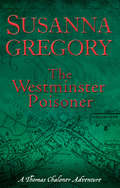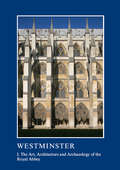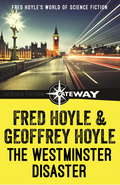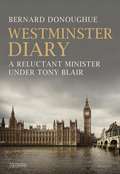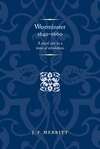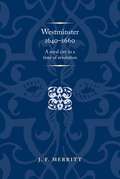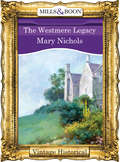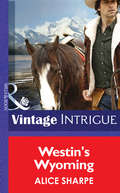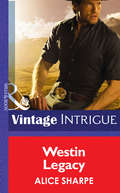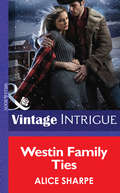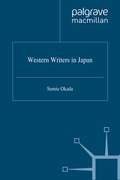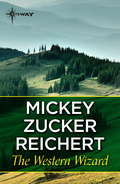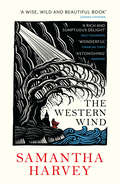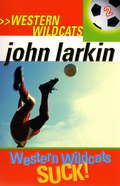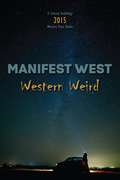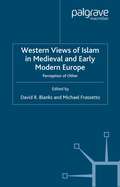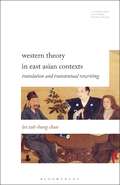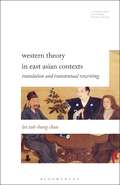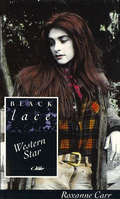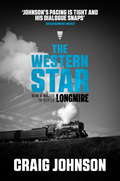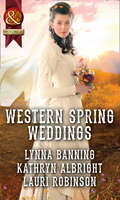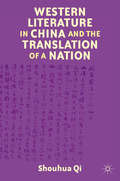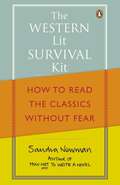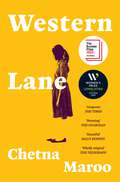- Table View
- List View
The Westminster Poisoner: 4 (Adventures of Thomas Chaloner #4)
by Susanna GregoryThe fourth adventure in the Thomas Chaloner series. Christopher Vine, a Treasury clerk working in solitary piety in the Painted Chamber of the Palace of Westminster, is not alone. A killer waits in the draughty hall to ensure Vine will not live to see in the New Year. And Vine is not the only government official to die that season. The Lord Chancellor fears his enemies will skew any investigation to cause him maximum damage, so he decides to commission his own inquiries into the murders and, with his suspicions centred on Greene, another clerk, he instructs Thomas Chaloner to prove that Greene is the killer. Chaloner can prove otherwise, but unravelling the reasons behind his employer's suspicions is as complex as discovering the motives for the killings. His search for the real murderer plunges him into a stinking seam of corruption that leads towards the Royal apartments and to people determined to make Christmas 1663 Chaloner's last . . .'Pungent with historical detail' (Irish Times)'A richly imagined world of colourful medieval society and irresistible monkish sleuthing' (Good Book Guide) 'Corpses a-plenty, exciting action sequences and a satisfying ending' (Mystery People)
Westminster Part I: The Art, Architecture and Archaeology of the Royal Abbey (The British Archaeological Association Conference Transactions)
by Warwick Rodwell Tim Tatton-BrownThe British Archaeological Association’s 2013 conference was devoted to the study of Westminster Abbey and the Palace of Westminster. It also embraced Westminster School, which was founded at the Reformation in the Abbey precinct. Collectively, these institutions occupy a remarkable assemblage of medieval and later buildings, most of which are well documented. Although the Association had held a conference at Westminster in 1902, this was the first time that the internationally important complex of historic buildings was examined holistically, and the papers published here cover a wide range of subject matter. Westminster came into existence in the later Anglo-Saxon period, and by the mid-11th century, when Edward the Confessor’s great new abbey was built, it was a major royal centre two miles south-west of the City of London. Within a century or so, it had become the principal seat of government in England, and this series of twenty-eight papers covers new research on the topography, buildings, art-history, architecture and archaeology of Westminster’s two great establishments — Abbey and Palace. Part I begins with studies of the topography of the area, an account of its Roman-period finds and an historiographical overview of the archaeology of the Abbey. Edward the Confessor’s enigmatic church plan is discussed and the evidence for later Romanesque structures is assembled for the first time. Five papers examine aspects of Henry III’s vast new Abbey church and its decoration. A further four cover aspects of the later medieval period, coronation, and Sir George Gilbert Scott’s impact as the Abbey’s greatest Surveyor of the Fabric. A pair of papers examines the development of the northern precinct of the Abbey, around St Margaret’s Church, and the remarkable buildings of Westminster School, created within the remains of the monastery in the 17th and 18th centuries. Part II part deals with the Palace of Westminster and its wider topography between the late 11th century and the devastating fire of 1834 that largely destroyed the medieval palace. William Rufus’s enormous hall and its famous roofs are completely reassessed, and comparisons discussed between this structure and the great hall at Caen. Other essays reconsider Henry III’s palace, St Stephen’s chapel, the king’s great chamber (the ‘Painted Chamber’) and the enigmatic Jewel Tower. The final papers examine the meeting places of Parliament and the living accommodation of the MPs who attended it, the topography of the Palace between the Reformation and the fire of 1834, and the building of the New Palace which is better known today as the Houses of Parliament.
Westminster Part I: The Art, Architecture and Archaeology of the Royal Abbey (The British Archaeological Association Conference Transactions)
by Warwick Rodwell; Tim Tatton-BrownThe British Archaeological Association’s 2013 conference was devoted to the study of Westminster Abbey and the Palace of Westminster. It also embraced Westminster School, which was founded at the Reformation in the Abbey precinct. Collectively, these institutions occupy a remarkable assemblage of medieval and later buildings, most of which are well documented. Although the Association had held a conference at Westminster in 1902, this was the first time that the internationally important complex of historic buildings was examined holistically, and the papers published here cover a wide range of subject matter. Westminster came into existence in the later Anglo-Saxon period, and by the mid-11th century, when Edward the Confessor’s great new abbey was built, it was a major royal centre two miles south-west of the City of London. Within a century or so, it had become the principal seat of government in England, and this series of twenty-eight papers covers new research on the topography, buildings, art-history, architecture and archaeology of Westminster’s two great establishments — Abbey and Palace. Part I begins with studies of the topography of the area, an account of its Roman-period finds and an historiographical overview of the archaeology of the Abbey. Edward the Confessor’s enigmatic church plan is discussed and the evidence for later Romanesque structures is assembled for the first time. Five papers examine aspects of Henry III’s vast new Abbey church and its decoration. A further four cover aspects of the later medieval period, coronation, and Sir George Gilbert Scott’s impact as the Abbey’s greatest Surveyor of the Fabric. A pair of papers examines the development of the northern precinct of the Abbey, around St Margaret’s Church, and the remarkable buildings of Westminster School, created within the remains of the monastery in the 17th and 18th centuries. Part II part deals with the Palace of Westminster and its wider topography between the late 11th century and the devastating fire of 1834 that largely destroyed the medieval palace. William Rufus’s enormous hall and its famous roofs are completely reassessed, and comparisons discussed between this structure and the great hall at Caen. Other essays reconsider Henry III’s palace, St Stephen’s chapel, the king’s great chamber (the ‘Painted Chamber’) and the enigmatic Jewel Tower. The final papers examine the meeting places of Parliament and the living accommodation of the MPs who attended it, the topography of the Palace between the Reformation and the fire of 1834, and the building of the New Palace which is better known today as the Houses of Parliament.
The Westminster Disaster (Fred Hoyle's World of Science Fiction)
by Fred Hoyle Geoffrey HoyleThe Westminster Disaster is based on the present world shortage of high-grade uranium and the action turns on a Soviet threat to use nuclear blackmail against London.When the British Ambassador to the U.N. seeks to veto a Soviet demand for sanctions against South Africa, the threat becomes a hideous reality.Writing from a position of intimate knowledge of advanced trends in research and science administration, in this novel the Hoyles give vivid expression to their deep fears about the present world situation and about carefully laid plans for Soviet domination...
Westminster Diary: A Reluctant Minister under Tony Blair
by Bernard DonoughueOn 2nd May 1997, Tony Blair swept into Downing Street, ending almost twenty years of Conservative government and beginning a decade as Prime Minister. Bernard Donoughue, a Labour peer in the House of Lords, chronicled the path to this momentous election victory in his diaries and this volume sheds new light on the process of forming government and on life working as a minister in the House of Lords. Infused with Donoughue's trademark wit and insight, the diaries covers daily life for a working peer – from the committees, bill discussion and public appearances to political spats – both policy-related and personal. Donoughue also casts a wry glance at a peer's extra-curricular events – from dinners and other high-profile social events to his own favourite hobby, horse-racing. Featuring a cast of high-profile political characters, this book is a must-read for fans of political diaries and anyone with an interest in the inside workings of Westminster
Westminster 1640–60: A royal city in a time of revolution (Politics, Culture and Society in Early Modern Britain)
by J. F. MerrittThis book examines the varied and fascinating ways that Westminster – traditionally home to the royal court, the fashionable West End and parliament – became the seat of the successive, non-monarchical regimes of the 1640s and 1650s. It first explores the town as the venue that helped to shape the breakdown of relations between the king and parliament in 1640–42. Subsequent chapters explore the role Westminster performed as both the ceremonial and administrative heart of shifting regimes, the hitherto unnoticed militarisation of local society through the 1640s and 1650s, and the fluctuating fortunes of the fashionable society of the West End in this revolutionary context. Analyses of religious life and patterns of local political allegiance and government unveil a complex and dynamic picture, in which the area not only witnessed major political and cultural change in these turbulent decades, but also the persistence of conservatism on the very doorstep of government.
Westminster 1640–60: A royal city in a time of revolution (Politics, Culture and Society in Early Modern Britain)
by J. F. MerrittThis book examines the varied and fascinating ways that Westminster – traditionally home to the royal court, the fashionable West End and parliament – became the seat of the successive, non-monarchical regimes of the 1640s and 1650s. It first explores the town as the venue that helped to shape the breakdown of relations between the king and parliament in 1640–42. Subsequent chapters explore the role Westminster performed as both the ceremonial and administrative heart of shifting regimes, the hitherto unnoticed militarisation of local society through the 1640s and 1650s, and the fluctuating fortunes of the fashionable society of the West End in this revolutionary context. Analyses of religious life and patterns of local political allegiance and government unveil a complex and dynamic picture, in which the area not only witnessed major political and cultural change in these turbulent decades, but also the persistence of conservatism on the very doorstep of government.
The Westmere Legacy (Mills And Boon Historical Ser.)
by Mary NicholsIsabella's grandfather, the Earl of Westmere, insists she take a husband – and she must choose which of her four second cousins it must be. In desperation, Bella turns to Robert Huntley, the cousin with whom she's shared many a childhood adventure.
Westin's Wyoming (Open Sky Ranch #1)
by Alice SharpeIt had been fifteen years since Pierce Westin stepped foot on the Open Sky Ranch. But after a mysterious phone call disrupted a life lived on the edge, the security expert agreed it was time to come home.
Westin Legacy (Open Sky Ranch #2)
by Alice SharpeFrom the moment Echo De Gris mysteriously returned to the Open Sky Ranch, Adam Westin felt the sparks fly. The girl he'd known was all grown up, however, trouble still followed her wherever she went.
Westin Family Ties (Open Sky Ranch #3)
by Alice SharpeCody Westin had been a man on a mission since the moment his wife, Cassie, walked away under a cloud of secrecy. She had her reasons, but a Westin never gives up without a fight.
Western Writers in Japan
by S. OkadaThis book relates the experiences of a range of Western writers who went to Japan as teachers and lecturers, covering a period of over 100 years. It discusses East-West cultural differences; Western 'individualism' encountering Japanese 'formal' society; and draws on the author's interviews with many of the writers featured. It includes some hitherto unpublished correspondence, as well as comments on their published works. The author hopes her book will encourage a deeper understanding between East and West.
The Western Wizard (Last Of The Renshai Ser. #Bk.2)
by Mickey Zucker ReichertWhen Odin breathed life into the mortal realms, he also created the Cardinal Wizards: the Northern Wizard as the representative of Good, the Southern as master of Evil, and the Western and Eastern as the keepers of the balance between Good and Evil, each neutral, both sharing the burden of holding their fellow magic wielders in check.But now the days decreed in ancient prophecy have come upon the mortal realms. The Great War has been fought and a Renshai has proven its Champion.Yet even as the war's heroes struggle to place the rightful king of Bearn upon his throne, and the also true Renshai seeks to train a new generation of his warrior race, the word is carried forth on falcon's wings that the Western Wizard is no more.And unless Shadimar, the Wizard of the East, can find the one mortal with any hope of surviving the challenge of the Seven Tasks of Wizardry, the worlds of gods and mortals alike will fall....
The Western Wind
by Samantha Harvey15th century Oakham, in Somerset; a tiny village cut off by a big river with no bridge. When a man is swept away by the river in the early hours of Shrove Saturday, an explanation has to be found: accident, suicide or murder? The village priest, John Reve, is privy to many secrets in his role as confessor. But will he be able to unravel what happened to the victim, Thomas Newman, the wealthiest, most capable and industrious man in the village? And what will happen if he can’t?Moving back in time towards the moment of Thomas Newman’s death, the story is related by Reve – an extraordinary creation, a patient shepherd to his wayward flock, and a man with secrets of his own to keep. Through his eyes, and his indelible voice, Harvey creates a medieval world entirely tangible in its immediacy.
Western Wildcats Suck: Western Wildcats 2 (Western Wildcats #2)
by John LarkinThe Western Wildcats are in trouble. About the only good thing you could say for their goalkeeper, Smokin (so called because he’s never without a Chupa Chup in his mouth!), is that he’s got a newish pair of gloves. He keeps taking off for the toilet or he’ll go to the canteen or home—right in the middle of a game! But he’s got a lot on his mind, what with his father building a blue and yellow (Go the Eels!) Chinese junk in their backyard and planning to sail off down the local creek and head for Hawaii. So do they really expect Smokin to keep for the entire game? Of course he’s not the only problem: some of Throw-in’s clearances are adding to the rings around Saturn, and Own-goal keeps scoring hat-tricks for the opposing team. Brazilian methods don’t seem to be working so far, but their coach is still trying. Is it any wonder, though, that people are saying the Western Wildcats suck?
Western Weird (Manifest West Series)
by Mark ToddThe 2015 theme for Manifest West’s annual anthology is “Western Weird.” The works in this collection reflect both myths and suspected truths about the part of the United States we call “the West.” But this year’s edition focuses entirely on the tradition of the strange. To borrow from Jeff VanderMeer’s definition for speculative fiction’s “New Weird,” this volume creates a new parallel genre for work that subverts the traditional romanticized ideas about place, playing with clichés about the West in order to put these elements to discomfiting, rather than consoling, ends. Topics included in this collection of poetry, fiction, and creative nonfiction range from the West’s numinous fascination with E.T., Bigfoot, and ghosts and its celebration of its indigenous fauna and deadly landscapes to its uncomfortable relationships with its own marginalized peoples and its unforgiving and sometimes violent traditions. The tone of these works ranges from light—even campy—to chilling, but all allow readers to gaze straight into the many faces of what makes the West a weird place. For the first time in the series, this volume includes solicited work as well as open submissions, including a number of established and award-winning writers and serving its mission by giving voice to brand-new writers. Western Weird is the fourth volume in Western Press Books’ literary anthology series, Manifest West. The press, affiliated with Western State Colorado University, annually produces one anthology focused on Western regional writing Contributors: Bredt Bredthauer, Bartholomew Brinkman, Amy Brunvand, George David Clark, Michael Luis Dauro, Carol V. Davis, Russell Davis, Joe DiBuduo, Michael Engelhard, Daniel Ervin, Mel Goldberg, R. S. Gwynn, Aline Kaplan, Don Kunz , Nate Liederbach, Ellaraine Lockie, Nathan Alling Long, Robert McBrearty, Teresa Milbrodt, Lance Nizami, William Notter, Marlene Olin, C. R. Resetarits, Kate Robinson, Michaela Roessner, David J. Rothman, Matt Schumacher, Renée Thompson, Wendy Videlock, Vivian Wagner, Kirby Wright
Western Views of Islam in Medieval and Early Modern Europe: Perception of Other
by Michael Frassetto David R. BlanksWestern Views of Islam in Medieval and Early Modern Europe considers the various attitudes of European religious and secular writers towards Islam during the Middle Ages and Early Modern Period. Examining works from England, France, Italy, the Holy Lands, and Spain, the essays in this volume explore the reactions of Westerners to the culture and religion of Islam. Many of the works studied reveal the hostility toward Islam of Europeans and the creation of negative stereotypes of Muslims by Western writers. These essays also reveal attempts at accommodation and understanding that stand in contrast to the prevailing hostility that existed then and, in some ways, exists still today.
Western Theory in East Asian Contexts: Translation and Transtextual Rewriting (Literatures, Cultures, Translation)
by Leo Tak-hung ChanLiteratures, Cultures, Translation presents a new line of books that engage central issues in translation studies such as history, politics, and gender in and of literary translation. This is a culturally situated study of the interface between three forms of transtextual rewriting: translation, adaptation and imitation. Two questions are raised: first, how a broader rubric can be formulated for the inclusion of the latter two forms within Translation Studies research, and second, how this enlarged definition of translation enables us to understand the incompatibilities between contemporary Western theories of translation and East Asian realities, past and present. Recent decades have seen a surge of scholarly interest in adaptations and imitations, due to the flourishing of cinema and fandom studies, and to the impact of a poststructuralist turn that sheds new light on derivative literature. Against this backdrop, a plethora of examples from the East Asian cultural sphere are analyzed to show how rewriters have freely appropriated, transcreated and recontextualized their source texts. In particular, Sino-Japanese case studies are contrasted with Sino-English ones, with both groups read against evolving traditions of thinking about free forms of translation, East and West.
Western Theory in East Asian Contexts: Translation and Transtextual Rewriting (Literatures, Cultures, Translation)
by Leo Tak-hung ChanLiteratures, Cultures, Translation presents a new line of books that engage central issues in translation studies such as history, politics, and gender in and of literary translation. This is a culturally situated study of the interface between three forms of transtextual rewriting: translation, adaptation and imitation. Two questions are raised: first, how a broader rubric can be formulated for the inclusion of the latter two forms within Translation Studies research, and second, how this enlarged definition of translation enables us to understand the incompatibilities between contemporary Western theories of translation and East Asian realities, past and present. Recent decades have seen a surge of scholarly interest in adaptations and imitations, due to the flourishing of cinema and fandom studies, and to the impact of a poststructuralist turn that sheds new light on derivative literature. Against this backdrop, a plethora of examples from the East Asian cultural sphere are analyzed to show how rewriters have freely appropriated, transcreated and recontextualized their source texts. In particular, Sino-Japanese case studies are contrasted with Sino-English ones, with both groups read against evolving traditions of thinking about free forms of translation, East and West.
Western Star
by Roxanne CarrIt is 1851. Maribel wants to see the Wild West; Dan is the frontiersman into whose care she is entrusted. Her campaign to seduce Dan is interrupted by her dalliance with a US cavalry man, who enjoys her skill with her whip and lariat. Then she is taken captive by a lustful native chief's son.
The Western Star: A Longmire Mystery (A Walt Longmire Mystery #13)
by Craig JohnsonIn the thirteenth novel in Craig Johnson's beloved New York Times bestselling Longmire series - now a hit Netflix series - Sheriff Walt Longmire faces a head-on collision of past and present, placing him and everyone he cares about squarely on the tracks of runaway revenge.Sheriff Walt Longmire is enjoying a celebratory beer after a weapons certification at the Wyoming Law Enforcement Academy when a younger sheriff confronts him with a photograph of twenty-five armed men standing in front of a Challenger steam locomotive. It takes him back to when, fresh from the battlefields of Vietnam, then-deputy Walt accompanied his mentor Lucian to the annual Wyoming Sheriff's Association junket held on the excursion train known as 'the Western Star', which ran the length of Wyoming from Cheyenne to Evanston and back. Armed with his trusty Colt .45 and a paperback of Agatha Christie's Murder on the Orient Express, the young Walt was ill-prepared for the machinations of twenty-four veteran sheriffs, let alone the cavalcade of curious characters that accompanied them. The photograph-along with an upcoming parole hearing for one of the most dangerous men Walt has encountered in a lifetime of law enforcement-hurtles the sheriff into a head-on collision of past and present, placing him and everyone he cares about squarely on the tracks of runaway revenge.
Western Spring Weddings: The City Girl And The Rancher / His Springtime Bride / When A Cowboy Says I Do (Mills And Boon Historical Ser.)
by Lynna Banning Kathryn Albright Lauri RobinsonSPRING WEDDING FEVER IN THE WILD, WILD WEST! The City Girl and the Rancher by Lynna BanningPenniless, Clarissa Seaforth leaps at gruff rancher Graydon Harris’s offer to become his cook. She’s never cared for a man before, but surely it can’t be hard to learn…?
Western Literature in China and the Translation of a Nation
by S. QiThis book studies the reception history of Western literature in China from the 1840s to the present. Qi explores the socio-historical contexts and the contours of how Western literature was introduced, mostly through translation and assesses its transformative impact in the cultural, literary as well as sociopolitical life of modern China.
The Western Lit Survival Kit: How to Read the Classics Without Fear
by Sandra NewmanThere they sit, the great tomes of classical literature, taunting you with their length and difficulty, as you ask: which books are the most important and why - and what's actually any good? Why does most writing about the classics have words like 'seminal' or 'oeuvre' in it? What does postmodernism mean? Can I get away with just reading the introduction?Now you can enjoy the classics without fear. This survival kit will guide you painlessly through the Western literary canon, century by century: from Ancient Greek drama to the modern novel, via Beowulf, Chaucer, Shakespeare, Romantic poetry, Tolstoy and Proust. There are entertaining plot summaries, unpretentious definitions of literary movements and fresh insights into authors' lives. With each work assigned ratings from 1 to 10 on Importance, Accessibility and Fun, you'll discover what's really worth bothering with and what you can safely discard without guilt.This book will make the things you've read clearer, inspire you to tackle the ones you've always meant to and make you sound far cleverer than you really are.
Western Lane: Shortlisted For The Booker Prize 2023
by Chetna MarooSHORTLISTED FOR THE BOOKER PRIZE 2023LONGLISTED FOR THE WOMEN'S PRIZE FOR FICTION 2024LONGLISTED FOR THE WILLIAM HILL AWARD 2023'A beautiful and evocative novel about grief, about growing up, about losing and winning. The people and places in this book will stay with me for a long time.' – Sally RooneySelected by Dua Lipa as one of Service95's 'Books of the Year'A 'Book of the Year' in The Economist, The Independent, The Week, The New York Times and The GuardianA deeply moving novel about grief, sisterhood and a teenage girl's struggle to transcend herself.Eleven-year-old Gopi has been playing squash since she was old enough to hold a racket. When her mother dies, her father enlists her in a quietly brutal training regimen, and the game becomes her world. Slowly, she grows apart from her sisters. Her life is reduced to the sport, guided by its rhythms: the serve, the volley, the drive, the shot and its echo.But on the court, she is not alone. She is with her pa. She is with Ged, a thirteen-year-old boy with his own formidable talent. She is with the players who have come before her. She is in awe.An unforgettable coming-of-age story, Chetna Maroo’s first novel is a moving exploration of the closeness of sisterhood, the immigrant experience, and the collective overcoming of grief.'With this gorgeous debut, Maroo blows most of the competition off the court.' – The Times'Stunning . . . Spare, tender, brilliantly achieved . . . A novel that unfolds in silences . . . and dares to leave much unsaid.' – The Guardian
